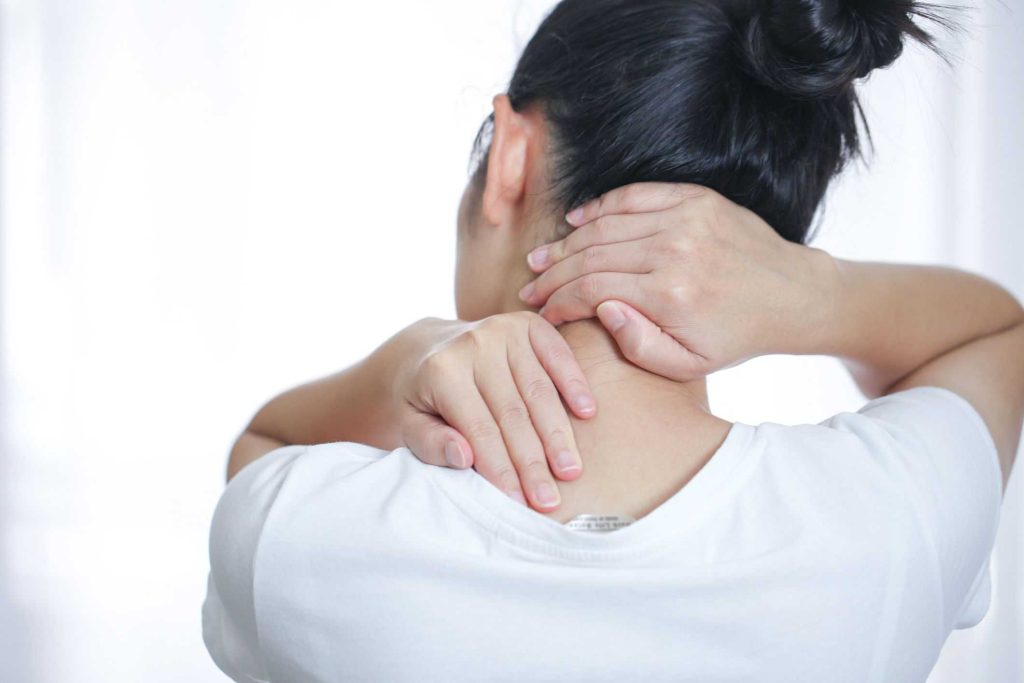Sometimes neck pain is treatable at home without a provider
Neck pain is a common health complaint. Many factors can cause neck pain, including something as simple as sleeping the wrong way or, for another example, having consistently poor posture when working or using electronics. To address neck pain, you can explore options such as icing or heating, neck stretches, and resting.
This article dives into ways to alleviate neck pain at home through self-treatment methods and alternative therapies.
:max_bytes(150000):strip_icc():format(webp)/standing-desk-stretch-GettyImages-1383390087-fac9735bfec94dbabd48645621d17a4f.jpg)
How to Get Rid of Neck Pain at Home
Coping with neck pain can be challenging. However, there are many things you can do in the comfort of your own home to address and relieve neck pain.
Self-Massage
Self-massage can work for neck pain because you control how much pressure you apply and to which particular area of focus. To perform a self-massage for neck pain:
- Pull your shoulders down away from your ears.
- Align your spine in a straight position while sitting or standing.
- Glide your fingers across your neck to find the most tender areas and apply firm pressure.
- In a circular motion, continue to apply firm pressure to the area first in a clockwise motion and then counterclockwise.
- Continue to massage the area for up to five minutes at a time.
Using a Massage Tool
If you want to take your self-massage a step further, invest in a massage tool. Research shows that massage tools can increase the level of relief a person experiences after a neck self-massage regarding chronic neck pain.1
Sleep on the Opposite Side
When you have neck pain that only affects one side of the neck, sleeping on the opposite side can relieve the pressure that may be causing the pain.
Consider a Standing Desk
Neck pain is often associated with poor posture from working at a desk for prolonged periods. It’s easy to hunch over while working and not think about your posture. It can worsen your neck pain if you continue to do so, leading to more severe neck and spinal alignment issues in the future.
To mitigate that, you could consider getting a standing desk. A standing desk provides you with the space you need to work, and standing while doing so allows you to pay more attention to your posture and avoid hunching.
Research has shown that working at a standing desk can significantly improve the health parameters associated with sitting too long, including neck pain.2
Home Traction Exercises
Home traction exercises, or cervical traction exercises, are another way to address neck pain at home. These movements work by pulling the head away from the body to decompress or stretch the spine. They also:
- Open up the spaces in the spine where nerves exit, leading to less pressure on a compressed nerve that’s causing pain
- Stretch muscles and joints in the neck to relieve pain
To perform neck traction exercises:3
- Lie on the edge of the bed with your face and torso pointing up toward the ceiling, your head at the edge of the bed, and your feet pointing toward the center of the bed.
- Hang your head and torso over the edge of the bed.
- Maintain this position for at least one minute.
- Repeat six times daily.
Research has found that these types of neck traction exercises can provide relief from chronic neck pain in as little as three weeks.3
At-Home Neck Traction Devices
If you want to take neck traction a step further, you can purchase an at-home neck traction device. That said, you will want to talk to a physical therapist or your healthcare provider beforehand so they can teach you how to use it properly and give you the go-ahead to use it.
Yoga
Yoga is a great exercise option for people with neck pain, especially if the pain is chronic. Research has found that doing yoga regularly with an emphasis on neck pain and positioning can reduce the pain and disability neck pain can cause.4
The exercise also helps to stabilize neck muscles and improve posture so that over time, neck pain will continue to improve.4
Cervical Pillow
A cervical pillow is designed to keep your neck in the best position while you sleep at night. It can aid in improving and preventing neck pain.
The cervical pillow is placed in a pillowcase and provides adequate neck support throughout the night by aligning it with the rest of your spine.
You can purchase a cervical pillow or make one at home. To make one:
- Fold a towel in half.
- Roll it up until it is about the length of your pillow.
- Slide it into the pillowcase and position it along the lower edge.
- Place your head on the pillow and ensure that it is in the proper place, which is underneath your neck.
A cervical pillow can be a great way to improve neck pain when used regularly alongside other pain relief techniques.5
Alternating Between Ice Packs and Heating Pads
Ice and heat can both relieve neck tension and pain. Hot therapy helps to relax the muscles and increase blood flow to the area to reduce pain, whereas ice helps to dull pain and reduce swelling. When using hot and cold therapy, alternate between the two for 20 minutes a few times per day.6
Dealing With Chronic Neck Pain
Acute and chronic neck pain feel the same way, but chronic pain does not go away as easily. When dealing with chronic neck pain, you can explore medical options for treatment with a healthcare provider, depending on the cause. You can also discuss the aforementioned options to ensure that you engage in them properly and can perform them independently.
Other possible therapies for chronic neck pain include:7
- Pain medications
- Muscle relaxants
- Wearing a cervical collar to support the spine
- Corticosteroid injections
- Surgery (in the most severe cases)
- Sleeping on an appropriate cervical pillow
Video: “Exercises for the CERVICAL SPINE”
SET OF EXERCISES №1 FOR THE CERVICAL SPINE. INITIAL STAGE OF RECOVERY
For additional information about the exercises for the Cervical spine you can watch a video demonstrating exercises and rehabilitation recommendations.
How Not to Get Rid of Neck Pain
You should avoid doing certain things so your neck pain doesn’t worsen. They include:
- Excessive stress, which can cause tightness in the muscles8
- Repeated neck movements while you are still in pain because they can cause issues with your spine and discs
- Spending too much time in a hunched-over or unnatural position while at work or at home9
- Jerking your neck around during exercise, driving, or other activities
Stress Management and Neck Pain
Stress can cause chronic neck pain because it drives tension in the neck muscles. To avoid stress-related neck pain, you can adopt specific stress management techniques, such as:10
- Getting regular exercise as long as it doesn’t worsen neck pain
- Eating a healthy diet that includes plenty of whole foods
- Practicing emotion regulation to avoid getting too stressed by difficult situations
- Trying meditation or mindfulness-based practices
- Purchasing a smartwatch that reads stress levels so you can adjust your lifestyle according to your stress triggers
How Providers Help to Get Rid of Neck Pain
If at-home techniques don’t work for you, you can explore some of the options that various healthcare providers offer. Some of these neck pain relief methods include:11
- Chiropractic adjustments: Adjustments to the neck and spine can relieve pain by reducing tension in the neck and improving posture.
- Massage therapy: Similar to self-massage, massage therapy will have the same effects, but a trained professional does it.
- Physical therapy: Physical therapists use a variety of pain-relieving tools and exercises to strengthen and massage the neck muscles to reduce tension and pain.
- Acupuncture: Research on acupuncture for neck pain is limited, but a small number of studies have found it effective. It works by inserting tiny, thin needles into pressure points on the body to relieve various ailments.
- Spinal manipulation: Spinal manipulation is performed by applying a controlled thrust to a specific part of the spine to help reduce pain.
Most Effective OTC Pain Relievers for Neck Pain
Over-the-counter non-steroidal anti-inflammatories (NSAIDs) such as Advil (ibuprofen) and Aleve (naproxen) can help relieve pain and inflammation. Tylenol (acetaminophen) can help relieve pain. Prescription muscle relaxants reduce tension in the neck muscles to relieve pain.11
Summary
Coping with neck pain can be difficult. The good news is that there are various ways you can relieve your neck pain at home, allowing you to experience reduced pain and a better quality of life. At-home treatments include self-massage, sleeping on the opposite side, using a cervical pillow, home traction, and alternating heat and cold.
The best at-home techniques are the ones that work for you, so you may have to try more than one before you find total relief. If the above methods for treating neck pain at home do not work, you can contact a healthcare provider. They can help you find the right specialist and an alternative therapy that will work for you.
Bottaro has a Bachelor of Science in Psychology and an Advanced Diploma in Journalism. She is based in Canada.

Check out the demo version of our sets of exercises for Cervical spine on YouTube
Our website presents the following sets of exercises for the cervical spine:






